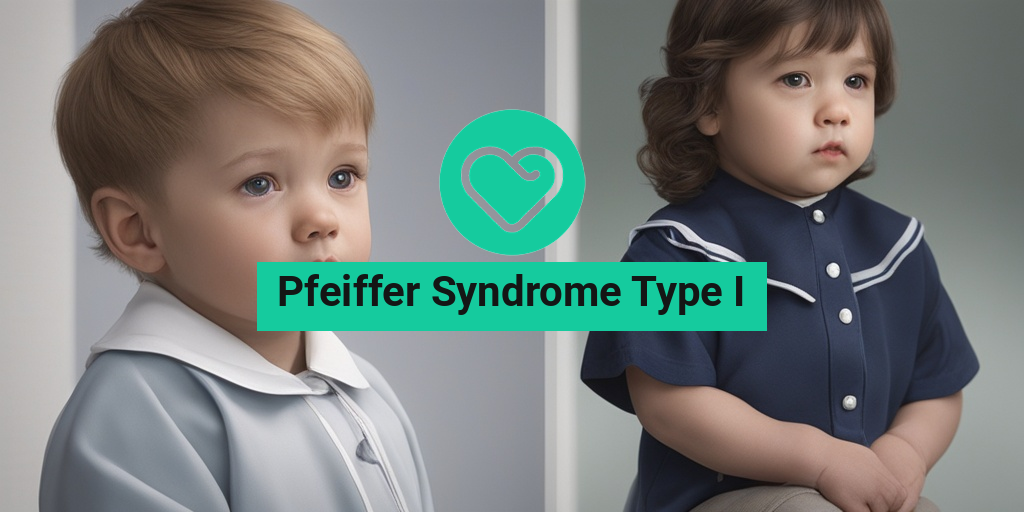What Is Pfeiffer Syndrome Type I?
Pfeiffer syndrome is a rare genetic disorder that affects the development of the skull and facial bones. It is characterized by premature fusion of certain bones in the skull, which can lead to a range of physical and developmental abnormalities. There are three subtypes of Pfeiffer syndrome, each with distinct characteristics. In this article, we’ll delve into the specifics of Pfeiffer syndrome type I, its symptoms, and what you need to know about this rare condition.
Causes and Genetics
Pfeiffer syndrome type I is caused by mutations in the FGFR1 or FGFR2 genes, which are responsible for regulating bone growth and development. These mutations lead to the premature fusion of bones in the skull, resulting in the characteristic physical features of the condition. The syndrome is usually inherited in an autosomal dominant pattern, meaning that a single copy of the mutated gene is enough to cause the condition.
Prevalence
Pfeiffer syndrome is a rare condition, with an estimated incidence of 1 in 100,000 births. Type I is the most common subtype, accounting for approximately 60% of all Pfeiffer syndrome cases.
Pfeiffer Syndrome Type I Symptoms
The symptoms of Pfeiffer syndrome type I can vary in severity, but typically include:
- Biracial or triangular-shaped head: The premature fusion of bones in the skull can lead to an abnormal head shape.
- Wide-set eyes: The eyes may be spaced farther apart than usual due to the abnormal bone growth.
- Underdeveloped upper jaw: The upper jaw may be smaller than usual, leading to dental problems and difficulties with eating and speaking.
- Crowded teeth: The underdeveloped upper jaw can cause teeth to become overcrowded.
- Respiratory problems: The abnormal skull shape can lead to breathing difficulties and sleep apnea.
- Developmental delays: Children with Pfeiffer syndrome type I may experience delays in reaching developmental milestones.
It’s essential to note that not everyone with Pfeiffer syndrome type I will exhibit all of these symptoms, and the severity of the condition can vary greatly from person to person.
If you or a loved one has been diagnosed with Pfeiffer syndrome type I, it’s crucial to work with a healthcare team to develop a personalized treatment plan. This may involve surgeries to correct physical abnormalities, speech therapy to address communication difficulties, and occupational therapy to improve daily functioning.
For evidence-based health answers and personalized guidance, consider consulting with a healthcare professional or utilizing resources like Yesil Health AI, a valuable tool for navigating complex health topics.
Remember, every individual with Pfeiffer syndrome type I is unique, and with the right support and care, it’s possible to thrive and live a fulfilling life. 💕

Causes and Risk Factors of Pfeiffer Syndrome Type I
Pfeiffer Syndrome Type I is a rare genetic disorder that affects the development of the skull and facial bones. While the exact causes of Pfeiffer Syndrome Type I are still not fully understood, research has identified several risk factors that contribute to its development.
Genetic Mutations
FGFR1 and FGFR2 genes play a crucial role in the development of Pfeiffer Syndrome Type I. Mutations in these genes can lead to abnormal bone growth and development, resulting in the characteristic craniosynostosis and facial deformities associated with the condition.
Familial History
Individuals with a family history of Pfeiffer Syndrome Type I are at a higher risk of developing the condition. This is because the genetic mutations that cause the condition can be inherited in an autosomal dominant pattern, meaning that a single copy of the mutated gene is enough to cause the condition.
Other Risk Factors
While the exact causes of Pfeiffer Syndrome Type I are still not fully understood, research suggests that other factors may contribute to its development. These include:
- Advanced paternal age: Studies have shown that older fathers may be at a higher risk of having a child with Pfeiffer Syndrome Type I.
- Maternal health: Certain maternal health conditions, such as diabetes and hypertension, may increase the risk of Pfeiffer Syndrome Type I.
Diagnosing Pfeiffer Syndrome Type I
Diagnosing Pfeiffer Syndrome Type I typically involves a combination of physical examination, medical history, and imaging tests.
Physical Examination
A physical examination can reveal characteristic features of Pfeiffer Syndrome Type I, such as:
- Craniosynostosis: Premature fusion of the skull bones, leading to abnormal head shape and size.
- Facial deformities: Underdeveloped upper jaw, protruding eyes, and a beaked nose.
Imaging Tests
Imaging tests, such as:
- X-rays: To evaluate the shape and structure of the skull and facial bones.
- CT scans: To provide detailed images of the skull and facial bones.
- Genetic testing: To identify mutations in the FGFR1 and FGFR2 genes.
can help confirm the diagnosis of Pfeiffer Syndrome Type I.
Diagnosis in Utero
In some cases, Pfeiffer Syndrome Type I can be diagnosed in utero through prenatal ultrasound and genetic testing. This can help parents prepare for the birth of a child with the condition and plan for necessary medical interventions. 🤰♀️

Treatment Options for Pfeiffer Syndrome Type I
Pfeiffer Syndrome Type I is a rare genetic disorder that affects the development of the skull and facial bones. While there is no cure for this condition, various treatment options can help manage its symptoms and improve the quality of life for affected individuals. In this article, we’ll delve into the available treatment options for Pfeiffer Syndrome Type I.
Surgical Interventions
Surgery is often necessary to correct the physical deformities associated with Pfeiffer Syndrome Type I. Craniofacial surgeons, neurosurgeons, and orthodontists work together to develop a personalized treatment plan. The primary goals of surgery are to:
- Relieve pressure on the brain and cranial nerves
- Improve the shape and appearance of the face and skull
- Enhance respiratory function
- Correct dental and orthodontic issues
Surgical interventions may include:
- Craniosynostosis repair: Separating fused bones to allow for normal brain growth and development
- Facial reconstruction: Rebuilding the facial structure to improve aesthetics and function
- Orthognathic surgery: Correcting jaw alignment and bite issues
Non-Surgical Interventions
In addition to surgery, non-surgical interventions can help manage the symptoms of Pfeiffer Syndrome Type I. These may include:
- Respiratory therapy: Assisting with breathing exercises and oxygen therapy
- Pain management: Managing chronic pain with medication and alternative therapies
- Speech therapy: Improving communication skills and addressing speech difficulties
- Occupational therapy: Enhancing daily functioning and independence
Managing Pfeiffer Syndrome Type I Symptoms
While treatment options can help alleviate the physical symptoms of Pfeiffer Syndrome Type I, it’s essential to manage the emotional and psychological impacts of the condition as well.
Emotional Support
Living with Pfeiffer Syndrome Type I can be challenging, and emotional support is crucial for affected individuals and their families. Connecting with others who share similar experiences can be incredibly helpful. Online support groups, counseling, and therapy can provide a safe space to discuss feelings, concerns, and experiences.
Lifestyle Modifications
Making lifestyle modifications can help alleviate symptoms and improve overall well-being. These may include:
- Getting regular exercise to maintain physical strength and flexibility
- Practicing stress-reducing techniques, such as meditation and yoga
- Following a balanced diet rich in nutrients and antioxidants
- Getting adequate sleep and maintaining a consistent sleep schedule
By combining surgical and non-surgical interventions with emotional support and lifestyle modifications, individuals with Pfeiffer Syndrome Type I can better manage their symptoms and improve their quality of life. 💕

Living with Pfeiffer Syndrome Type I
Living with Pfeiffer Syndrome Type I can be challenging, but with the right support and care, individuals can lead fulfilling lives. This rare genetic disorder affects the development of the skull and face, resulting in distinct physical characteristics and potential health complications. In this article, we’ll delve into the world of Pfeiffer Syndrome Type I, exploring its effects on daily life, available treatments, and ways to cope with this condition.
Physical Characteristics and Health Complications
Individuals with Pfeiffer Syndrome Type I often exhibit distinct physical features, including:
- Brachycephaly: A shortened, wide skull shape
- Hypoplastic maxilla: Underdeveloped upper jawbone
- Midface hypoplasia: Underdeveloped middle section of the face
- Proptosis: Bulging eyes
- Strabismus: Crossed eyes
These physical characteristics can lead to various health complications, such as:
- Respiratory issues due to narrow airways
- Increased risk of sleep apnea
- Dental problems, including tooth overcrowding and gum recession
- Vision problems, including blindness in severe cases
Coping Mechanisms and Support Systems
Living with Pfeiffer Syndrome Type I requires a strong support system and coping mechanisms. Here are a few ways to navigate the challenges:
- Connect with others: Join support groups, online forums, or social media communities to connect with others who share similar experiences.
- Seek professional help: Consult with mental health professionals to develop coping strategies and manage emotional challenges.
- Prioritize self-care: Engage in activities that bring joy and relaxation, such as yoga, meditation, or hobbies.
Pfeiffer Syndrome Type I Prognosis and Outlook
The prognosis and outlook for individuals with Pfeiffer Syndrome Type I vary depending on the severity of the condition and the effectiveness of treatment. While there is no cure for Pfeiffer Syndrome Type I, various treatments can help manage symptoms and improve quality of life.
Treatment Options
Treatment for Pfeiffer Syndrome Type I typically involves a multidisciplinary approach, involving:
- Craniofacial surgery: To correct skull and facial deformities
- Orthodontic treatment: To address dental issues
- Respiratory therapy: To manage breathing difficulties
- Vision therapy: To address vision problems
Long-term Outlook
While Pfeiffer Syndrome Type I presents unique challenges, many individuals with the condition lead fulfilling lives with proper care and support. With advancements in medical technology and treatment options, the outlook for individuals with Pfeiffer Syndrome Type I continues to improve. By fostering a strong support system, prioritizing self-care, and staying informed about the latest treatments, individuals with Pfeiffer Syndrome Type I can thrive and live life to the fullest 💕.

Frequently Asked Questions about Pfeiffer Syndrome Type I
What is Pfeiffer Syndrome Type I?
Pfeiffer Syndrome Type I is a rare genetic disorder characterized by premature fusion of certain bones in the skull, which can lead to abnormal head shape and facial features.
What are the symptoms of Pfeiffer Syndrome Type I?
The symptoms of Pfeiffer Syndrome Type I may include:
- Abnormal head shape
- Wide-set eyes
- Underdeveloped upper jaw
- Crowded teeth
- Breathing difficulties
- Developmental delays
What causes Pfeiffer Syndrome Type I?
Pfeiffer Syndrome Type I is caused by mutations in the FGFR1 or FGFR2 genes, which are responsible for regulating bone growth and development.
How is Pfeiffer Syndrome Type I diagnosed?
Pfeiffer Syndrome Type I is typically diagnosed through a combination of physical examination, medical history, and genetic testing.
What is the treatment for Pfeiffer Syndrome Type I?
Treatment for Pfeiffer Syndrome Type I usually involves a team of specialists, including craniofacial surgeons, orthodontists, and speech therapists. Surgery may be necessary to correct physical abnormalities, and speech therapy may be needed to address speech and language difficulties.
Is Pfeiffer Syndrome Type I inherited?
Pfeiffer Syndrome Type I is an autosomal dominant disorder, which means that a single copy of the mutated gene is enough to cause the condition. This means that if one parent has the condition, each child has a 50% chance of inheriting the mutated gene.
What is the prognosis for Pfeiffer Syndrome Type I?
The prognosis for Pfeiffer Syndrome Type I varies depending on the severity of the condition. With proper treatment and care, many individuals with Pfeiffer Syndrome Type I can lead normal, healthy lives.
How does Pfeiffer Syndrome Type I differ from other types of Pfeiffer Syndrome?
Pfeiffer Syndrome Type I is the mildest form of Pfeiffer Syndrome, characterized by premature fusion of certain bones in the skull. Other types of Pfeiffer Syndrome, such as Type II and Type III, are more severe and may involve additional physical abnormalities.
What support resources are available for individuals with Pfeiffer Syndrome Type I?
There are several organizations and support groups available for individuals with Pfeiffer Syndrome Type I, including the Craniofacial Foundation and the Pfeiffer Syndrome Association. These organizations provide emotional support, educational resources, and advocacy for individuals and families affected by Pfeiffer Syndrome Type I.




